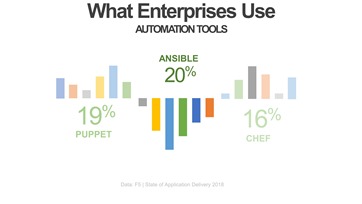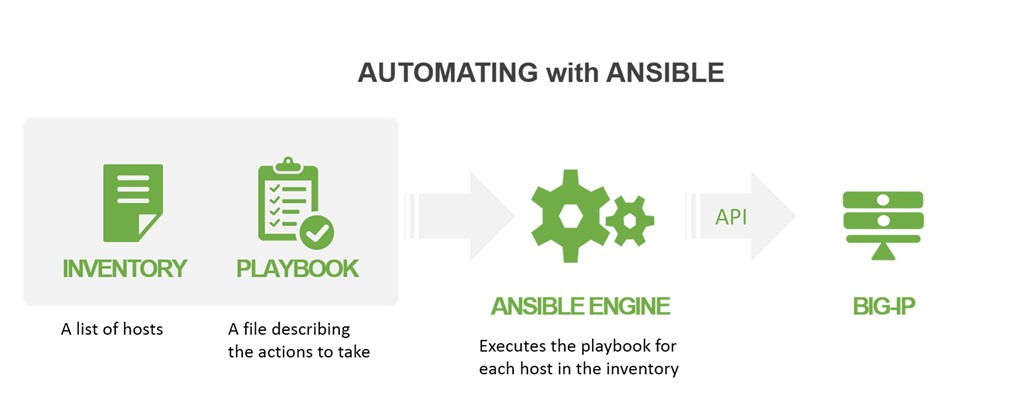开源焦点: Ansible 2.5 中 F5 的新功能

- Ansible 2.5现已推出
- 新的F5 模块已添加更多安全配置文件、许可支持和监控
- 您可以在Github上获取有关我们的 F5 Ansible 模块组合的更多信息
自动化是目前席卷企业 IT 的 DevOps 部署方法的核心组件。 虽然我们只看到少数(有些人可能会说是勇敢的,其他人可能会说是疯狂的)组织 100% 的时间使用自动化来推动生产中的重大和微小变化,但大多数组织现在至少都在部分使用自动化。 随着数字化转型对 IT 施加压力,使其以只有自动化才能匹敌的速度扩展,这种用途将继续扩大。
这意味着网络运营必须参与自动化游戏,使用行业工具。 根据我们最新的application交付状况报告,这些工具主要是 Ansible、Puppet 和 Chef。
但在 NetOps 做到这一点之前,我们这些提供所需(通常是必需的)网络和应用服务的人有责任支持这些工具集,以便大规模安全地交付应用程序。
这就是我今天写这篇文章的原因。 长期以来,F5 一直通过提供 Ansible 模块来支持 NetOps 实现自动化的发展。 Ansible 2.5 的发布也不例外,我们很高兴地注意到,我们既增强了现有的 F5 模块,也添加了新的模块以扩展对安全性的支持(甚至可能将 SecOps 纳入自动化游戏)。
如果你不熟悉使用 Ansible 进行自动化,以下是 30 秒的介绍: Ansible 是一个开源的无代理引擎,可以按照剧本中的指令自动配置一个或多个主机。

它是一个声明性模型,这意味着剧本描述动作并提供值(如主机名或 IP 地址或特定设置,如负载均衡算法),仅此而已。 Ansible 模块的任务是读取剧本并执行命令以实现所需的结果。 Ansible 引擎可以在台式机、笔记本电脑或服务器上运行。
它非常适合采用基础设施即代码方法进行部署的组织,并且可以使用户免受模块随时间变化的影响。 因此,即使 BIG-IP 发生根本性变化,需要更新 Ansible 模块,也不会影响现有的剧本。 您可以在 DevCentral 上阅读有关 BIG-IP 和 Ansible的更多信息,以及查找剧本示例并获得使用两者的帮助。
无论您是刚刚入门还是 Ansible 专业人士,您都希望了解 Ansible 2.5 中与 BIG-IP 相关的新功能。 我会支持你的。 我们添加了模块来支持高可用性、BIG-IP ASM 配置文件、BIG-IP AFM 策略以及 iApp LX 支持等。 这是对现有模块的补充,涵盖了 BIG-IP 提供的广泛负载均衡和安全功能。 带有可点击链接的完整列表位于折叠下方。
Ansible 是最受欢迎的网络和应用服务自动化工具之一。 我们很高兴成为 Ansible 社区的一部分,并支持 NetOps 通过 DevOps 转向更加自动化、软件驱动的部署模型。
让所有事情自动化!
以下是 Ansible 2.5 中新功能的部分列表:
Ansible 模块 |
描述 |
管理 BIG-IP 上的 AFM 地址列表 |
|
管理 BIG-IP 上的 AFM 端口列表 |
|
从文件或现有模板导入 ASM 策略 |
|
管理 BIG-IQ 注册密钥池中的许可证 |
|
管理 BIG-IQ 上的注册密钥池 |
|
BIG-IP HA 配对 |
|
将 iApps LX 包部署到 BIG-IP |
|
管理 BIG-IP 上的 LTM 策略规则 |
|
管理 F5 BIG-IP LTM UDP 监视器 |
|
管理 F5 BIG-IP LTM HTTPS 监视器 |
|
管理 BIG-IP 上的流量组 |
|
管理 BIG-IP 上的 vCMP 客户端 |
|
管理 BIG-IP 上的客户端 SSL 配置文件 |
